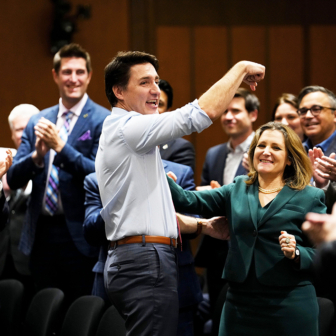Unlike the 2010 federal election, which was contested over rival leadership credentials, the 2013 election was largely a battle of slogans – of simplistic catchphrases repeated again and again by leaders, frontbenchers, backbenchers and major party candidates. The resort to sloganeering was in one sense a rational (if cynical) response to the state of the Australian political debate: the increasing resort to headline statements, often lacking in specificity and devoid of detail; the risk-aversion that characterises hyper-adversarial politics, with parties concentrating on attacking their opponents while allowing no chinks in their own armour; and the fact that many voters had made up their minds about their voting intentions some months before the poll and needed reminding rather than persuading.
Once the campaign got under way, the major parties promoted the concept of change and renewal: a new beginning, a “new way,” or a “new plan.” The consistency of these aspirational mantras suggests that all of the parties believed the electorate was exasperated by the previous period in politics and especially the infighting of the Labor ministry. But when these positive messages failed to resonate, they were quickly jettisoned (especially by Labor) in favour of direct negative attacks on opponents and negative advertising generally. Some of the minor parties continued to promote change and renewal, feeding on a general sense of disaffection.
Neither of the major parties was strong on policy detail, but the Coalition was particularly reticent. When slogans substitute for detailed policy, the electorate is asked to agree with the sentiment rather than analyse whether the policy is plausible, reasonable and acceptable. Pockets of opposition and voices of dissent are also less likely to erupt. But it is hard to cost or quantify slogans, a problem that underlay Labor’s complaint that the Coalition had failed to match its detailed Department of Finance costings for key policies. The Coalition did eventually release some information and claimed that its policies had been rigorously costed.
Between the two major parties there were serious disagreements (over the carbon tax, the resource rental tax, the dimensions of the fiscal problem, and the better parental leave scheme, for instance) but also surprising areas of agreement, though that didn’t necessarily neutralise issues in the minds of voters. Both major parties tried to outbid each other on tough treatment of asylum seekers, on infrastructure, defence and educational funding, on creating a more productive economy and providing the necessary skills and training, and on the need to fund a national disability care scheme based on client choice.
Both announced cuts in public services and in the number of public servants employed by the Commonwealth. Labor’s reductions (of 12,000–14,000), announced well before the election campaign, were presented as prudent government policy imposed through the “efficiency dividend.” When their conservative opponents promised further cuts, however, Labor denounced them as irresponsible and heartless. The Coalition implied it would cut as many as 16,500 public servants and reduce the number of agencies, and it was widely assumed that this figure was in addition to the Labor cuts, making reductions of up to 25,000 officials possible (as the public sector unions often claimed). Later, however, the Coalition clarified that it was seeking 16,500 redundancies or separations in total. The fear of job losses and counter-threats over public sector cuts consumed much of the election “heat,” although the fact that both sides were engaged in the same exercise largely neutralised the issue.
The mantras were also directed explicitly at adversaries and protagonists. While Kevin Rudd painted his opponent as an untrustworthy figure who had a secret austerity agenda, Tony Abbott continued to repeat three-word slogans, including “stop the boats,” “turn back boats,” “axe the tax,” “big new tax” and, occasionally, “just say no.” The Coalition leader’s strategy was to relentlessly drill these wedge issues into the electorate’s consciousness. Rudd responded with a counter-slogan accusing Abbott of seeking “cuts, cuts, cuts.”
With the election underway, Joe Hockey, Tony Abbott and Andrew Robb began to emphasise that Australia was facing a “budget emergency.” The persistence of a sizeable deficit and growing levels of debt were sufficient to underscore this message in the minds of voters, despite Labor’s attempts to argue that they were relatively small in international terms. Both Abbott and Hockey also promised to balance the budget well before the date by which Labor had committed to do so. To provide some reassurance that any government he would lead would not impose outright austerity on ideological grounds, Abbott promised that there would be “no unnecessary tax increases” and infamously told SBS TV on the eve of the election that there would be “no cuts to education, no cuts to health, no change to pensions, no change to the GST and no cuts to the ABC or SBS.” These commitments were meant to reassure vacillating voters, but would come back to haunt the Coalition in government. Here was one of the dilemmas at the heart of Abbott’s gambit: going hard and negative in opposition helped him to win government but also shaped voters’ perceptions of how he would behave in once he got there.
Despite honing their mantras, the parties used so many during the campaign that ultimately few of them resonated. There were no “cut-through” messages or consistent themes of the kind John Howard managed in 2001, with his assertion that “we will decide who comes to this country and the circumstances in which they come,” and none of the kind of momentum Kevin Rudd generated in 2007 with his Kevin07 brand. In that sense, the 2013 election campaign was a lackadaisical affair during which both sides, for different reasons, went through the motions without expecting a fundamental shift in public opinion, though Labor at least hoped to contain losses.
As was the case in previous elections, the party campaigns were highly stage-managed. Centrally planned, leader-centred strategies and schedules dominated, with bottom-up campaigns from local electorates enhancing candidate recognition and reinforcing key messages. Protagonists stayed on script almost to the point of tediousness (or, as in the case of Jaymes Diaz, who could not recall the Coalition’s six-point border protection policy, were airbrushed from view). “Noddy shots” had the local candidate looking serious and nodding sagely at every utterance of the leader. Setpiece images showed candidates desperately trying to fit in with the local communities they visited. Flimsy gimmicks and disingenuous photo opportunities for the nightly news underscored the blandness of the contest and further dumbed it down.
Image manipulation again proved powerful. In his post-election analysis Brian Loughnane, federal director of the Liberal Party, argued that the Coalition 2013 victory was the result of a combination of factors: Labor’s broken commitment not to introduce a carbon tax; Labor’s inability to deal with border security; issues of economic management; and the soap opera saga of Labor’s disunity in government, which culminated when Julia Gillard was supplanted by the leader she had previously replaced, Kevin Rudd. Loughnane readily acknowledged the important role of support groups for local Coalition candidates, including improved use of social media technology and micro-targeting of key voters. And he emphasised that the Liberals also ran a positive agenda, concluding that “while Labor’s internal crisis provided opportunity for the Coalition, it was not inevitable that we would win the election. The community wanted something to vote for, not just against.”
Needless to say, aspects of Loughnane’s analysis might strike his political opponents and some academic commentators as contentious. The role played by Labor disunity is widely acknowledged, even by Labor Party officials, but Loughnane’s depiction of Labor’s “chaos, instability and dysfunction” fails to acknowledge the Coalition’s key role in promulgating and manipulating that image for its own electoral ends. It ignores the fact that the Gillard government alone passed over 500 pieces of legislation, that none of its bills were defeated in the House of Representatives (although some that might have been were not put forward or were allowed to lapse), and that it was far more successful at passing legislation through a hostile Senate than have been many previous governments (or the subsequent government).
While Labor might claim, as its national secretary George Wright has done, that the Rudd and Gillard governments “kept Australia out of a world recession” and pursued worthwhile policies in education, communications and disability, it didn’t manage to sell its reform credentials effectively. That failure reflected not only poor communication strategies and major problems in implementation, but also Labor’s internal machinations. Rudd, for example, was loathe to acknowledge Gillard’s achievements once he returned to the Lodge.
Elections are normally decided by a complex combination of factors and the 2013 Australian election was no exception. The preferential nature of the Australian voting system is wide open to manipulation, for instance, and preference swapping has now become both a dark art and a science. As Antony Green commented, preferences played an essential role in keeping Labor competitive, given what he calls a “disastrous decline” in its first preference votes. The Greens survived in the upper house largely on preferences. But other minor players also got in on the act. Green notes that “in both the House and Senate, support for non-major party candidates rose to levels never previously recorded at an Australian national election” and candidates were elected on infinitesimally small primary votes, with many voters unaware that their preferences were being channelled to these candidates. Institutional factors, including the “light touch” regulation of campaign financing and the relative ease with which minor parties can be formed, also played a role.
Reactions to continuous opinion polling may also have been influential. Regular polling tends to focus on calculating the likely two-party-preferred outcome, and this not only affects the behaviour of the principal contestants but also shapes the expectations of the electorate as to the likely outcome. Voters’ expectations of who will win can have a marked impact on the directions of their own voting intentions. Yet, as political scientist Murray Goot noted, even though the polls were accurate in predicting overall trends, they were often less successful at predicting outcomes in selected regions and specific seats (for example, western Sydney and some key battlefield seats across the nation – such as Moreton). It is here that complex regional factors came into play, as did the success of the major parties in sandbagging vulnerable seats using not only traditional methods such as door-knocking but also social media and sophisticated databases that allow micro-targeting.
Minor parties, meanwhile – including exceptionally well-funded new ones such as the Palmer United Party, and unexpectedly successful local campaigns run by independents like Cathy McGowan in Indi – influenced the outcome in particular seats and in the Senate. In the case of the 2013 election, the Greens also had a notable success in retaining Adam Bandt’s seat of Melbourne, although some Greens felt that other winnable seats were sacrificed in order to shore-up Bandt’s seat for symbolic reasons.
As former political advisor Nicholas Reece has eloquently described, campaigners carefully assessed the marketability of specific policy issues. Economic management issues, fear of government debt and concerns over personal financial security were key longstanding issues, and the carbon tax loomed large before and during the campaign. In their analysis of the 2013 Australian Election Study survey results, Clive Bean and Ian McAllister confirm the role of issues made more salient by the parties themselves: promises to solve the issues of economic management, stem the flow of asylum seekers and reduce taxation influenced support for the Coalition, while the Labor Party’s record and commitments to education and health continued to influence support for its candidates in the campaign.
Interestingly, though, the political scientists Rob Manwaring, Gwen Gray and Lionel Orchard highlighted the Coalition’s success in partially neutralising issues that might have worked to its disadvantage, such as health and education, thereby cauterising Labor’s scare tactics about cuts under an Abbott government. Meanwhile, as Kirsty McLaren and Marian Sawer have argued, both major parties attempted to mobilise the masculinity of the two leaders in their stage-managed campaigning, and in the process important issues involving women were marginalised.
In the aftermath of the election, some commentators argued that the result was not quite as devastating a defeat for Labor, and conversely not quite as convincing a win for the conservatives, as was commonly believed. But such a view only holds up if the election is looked at totally in isolation, whereas we would argue the 2010 and 2013 elections should be judged together in terms of a two-stage trajectory that removed Labor from government. The combined swing to the Coalition from 2007 to 2013 was 3.78 per cent in the primary vote and 6.19 per cent in two-party-preferred terms.
Moreover, Labor’s primary vote in 2013 was the lowest recorded in 110 years. In the twenty-eight federal elections since 1943, Labor’s vote only fell below 40 per cent on six previous occasions (in 2010, 2004, 2001, 1996, 1990 and 1977), which suggests a serious structural malaise in recent decades. In 2013 it fell to 33.38 per cent, a further swing of 4.61 per cent from Labor’s result in 2010, and a combined swing of exactly 10 per cent since the Kevin07 election of 2007. Its two-party-preferred vote was 46.51 per cent, a swing against the party of 3.61 per cent. Labor’s two-party-preferred vote was almost identical to that of its loss in 1996 (a mere 0.14 per cent difference at 46.38 per cent in 1996) and one would have to go back to the spectacular losses in 1975 and 1977 to find lower two-party-preferred votes. In the twenty-four elections since 1949, Labor’s two-party-preferred vote was higher than in 2013 on eighteen occasions, and only on six was it lower (in 1955, 1958, 1966, 1975, 1977 and 1996).
Labor’s sanguine attitude to the election result, as reflected by the assessment of campaign director George Wright, was probably due to the fact that it expected to be mauled more severely and was relieved that much of its frontbench talent managed to survive the defeat. Labor was far less sanguine about its Senate vote, where it lost six positions and was reduced to twelve returning senators (with only one position re-elected from each of two mainland states, South Australia and Western Australia), reducing their total representation to twenty-five, less than a third of the chamber.
The Coalition’s primary support was far from their highest winning margin. In terms of primary votes, Abbott’s win was close to the party’s average result, but lower than eleven previous election victories since the previous hung parliament of 1941–43 (namely, in 2004, 1996, 1980, 1977, 1975, 1966, 1963, 1958, 1955, 1954 and 1949). Significantly, its 2013 result was also below that of two Coalition losses (the elections of 1987 and 1974). Moreover, in two-party terms the Coalition didn’t manage to attract a consistent nationwide swing, and did not achieve a majority in three out of the eight jurisdictions (Victoria, Tasmania and the ACT). The Coalition also lost one Senate seat in Victoria to the Motoring Enthusiast Party.
Hence, while the 2013 election was a further defeat for Labor and at the time part of a longer trend in sliding support, it was not a spectacular win for the Coalition. That 21.07 per cent of the electorate either voted for parties/candidates other than the major parties, or voted informally, suggests a high degree of voter disaffection. If the fact that some 1.5 million Australian adults are entitled to be on the electoral roll but have not registered because they are not interested in politics is taken into account, then there is a substantial measure of societal disaffection with the politics on offer. This feature is less evidence of a “democratic deficit” than of a deep-seated disaffection with the current state of democracy and political parties and politicians. Opinion polls of younger voters especially have indicated a high degree of questioning over the value of democracy or its effectiveness as a preferred system of government.
The Greens would also not be content with their level of electoral endorsement; they suffered swings against them of 3.11 per cent in the lower house and 4.46 in the Senate. Although their representation increased by one senator, their upper house representation was almost totally dependent on preference flows from the Labor Party and some smaller minor parties. By 2013 the Greens seemed to have inherited the status of “least worst” among the minor parties, a position once held by the Australian Democrats.
There’s an obvious flip side to Abbott’s relentless, and electorally successful, pillorying of Gillard for reversing her commitment not to introduce a carbon tax. The Coalition itself made commitments in the lead-up to the 2013 election and, given how it had railed so vehemently against broken promises since 2010, voters could reasonably expect it to be bound to honour these commitments to the letter (especially the commitments to stop the boats, abolish the carbon and mining taxes, introduce no new taxes and not change the GST, not cut pension benefits or education and health budgets, and preserve the funding for the public broadcasters). In many ways Abbott painted himself into a tight corner with his “preserve the status quo” commitments, leaving his government little room to manoeuvre without being forced to reverse them.
In an era of perpetual election cycles and constant campaigning, the parties have already begun to assess how they should be positioning themselves for the next election, whenever that takes place, and under whatever circumstances. Parties, like military generals, tend to fight the next campaign according to their own post mortem of their performance in the last one, building on what aspects they did well and rectifying those aspects that went badly. So we might expect the Coalition to include greater policy detail and be more forthcoming in their appeal to voters; Labor to stress unity, stability and consistency; the Greens to become less amorphous and prone to ambulance chasing; and Palmer and some of the other fringe parties to better hone their appeals to the disaffected while continuing to entertain.
But these are more volatile times. The previous conservative government lasted four successive terms, looked competent for most of that time and frequently out-manoeuvred its Labor opponents. The Abbott government began office somewhat shakily (as did Howard in 1996 and Rudd in 2008) and it quickly became apparent that it had not fully mastered the art of government. While the Coalition’s party discipline and unity in opposition helped to deliver it victory, the imperatives of government are more pressing, especially in a time of reduced revenues, and are likely to re-open old divisions and internal debates.
Labor, meanwhile, appeared to have been partially successful in its strategy of saving the furniture and the cherished careers of its frontbench team, but does that provide a sufficient base on which to rebuild the party’s fortunes without some major internal changes, a reassessment of what the party stands for and the cultivation of a more attractive appeal to voters? Labor’s disastrously low primary vote may remain an enduring concern into the future, particularly given the Greens long-term goal of challenging the “century-long” stranglehold that the major parties have on the Australian political system. Yet the Greens are not the only party fighting for the “protest vote” and peeling voters from the major parties. The initial spectacular showing of the well-resourced Palmer group captured protest votes from the major parties and from other minor parties alike.
Sixteen months later, and after enduring a very public challenge to his leadership from his party colleagues, Tony Abbott has made many of the same mistakes he accused his Labor predecessors of committing, and has failed to deliver what he frequently called “adult government.” His government has displayed a shallowness of policy, a lack of conviction about core objectives, poor communication, poor political judgment and a tendency to play party politics rather than to govern in the nation’s interest. Like his Labor predecessor, his government was destabilised not by his lacklustre political opponents but by his own colleagues in the party room. The government did not take the budget emergency mantra seriously and wasted the opportunity to build fiscal consolidation so that they would eventually have the latitude to implement new spending proposals. Its first budget was a mess of contradictory proposals that was poorly sold and potentially created many losers; it was widely perceived as unfair and badly targeted. In particular, many voters believed that Abbott had broken his election promise that he could fix the budget without cutting areas such as health and education.
The government also struggled to explain the impact on their budget bottom line of global financial uncertainty and falling revenues, a particularly striking omission given that they had dismissed the Labor governments’ arguments about the impact of these factors during the election campaign and had suggested that rising budget deficits were only due to Labor’s high spending (and were therefore relatively easily fixed). On the legislative front, the government seemed paralysed, with many of its measures either deferred from consideration or blocked in the hostile Senate. Abbott’s critique of Labor’s minority government (and the deals needed to keep it in office and get legislation through) had failed to alert voters to the fact that, while it might win a majority in the lower house, the Coalition would not win a majority in the Senate. During its first sixteen months, the government did not show any particular aptitude in negotiating its legislative agendas with either the Labor opposition or the cross-bench senators. Consequently, it soon seemed to be reneging on its promise to offer stable government that would leave the claimed dysfunction and chaos of the Labor years behind. Even business supporters complained about the ensuing policy uncertainty.
Abbott’s gambit strategy of going in hard-and-fast with negative attacks on the Labor governments had served him well in opposition but had given the electorate somewhat unrealistic expectations of how his government would perform. To many observers, the Coalition wasted its mandate and its honeymoon in record time. Indeed, most of the press gallery and political commentariat has already written off Abbott’s chances of remaining prime minister in the immediate future. •




